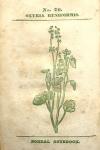No. 70. Oxyria reniformis.
 Names. Boreal Sourdock.
Names. Boreal Sourdock.
Fr. Oxyrie reniforme.
Vulgar. Mountain Sorrel, Welsh Sorrel.
Classif.Nat. Ord. Polygonia. Diandria digynia L.
Genus OXYRIA. Calix simple four leaved, two inner folioles larger; no corolla; 2 to 6 stamens; two styles, stigmas plumose; nut compressed, with a broad winged margin.
Sp. Oxyria reniformis. Stem branched erect; radical and lower leaves on long petioles, reniform, undulate, upper rounded lobed; flowers in slender racemes.
Description. Root perennial; stem a foot high or less, erect, slender, with alternate branches; radical leaves on very long petioles, kidney shaped, obtuse, thick, smooth, with waved margin; stem leaves alternate petiolate, subcordate, rounded, emarginate, sinuate or lobed; flowers in slender terminal and naked racemes, often geminate, opposite, reddish; calyx with two outer oblong folioles, and the two inner ones double the size, and obovate; fruit one seeded, nut-like, winged around, lenticular, wing membranaceous; stamina from two to six.
History. This plant was the Rumex digynus of Linnaeus, lately made a peculiar genus by R. Brown, and very properly. It grows in the North of Europe, and the Boreal part of America, in Greenland, Labrador, and Canada. It blossoms in the spring. The whole plant has a sour austere taste, like Sheep-sorrel or Rumex acetosella, so common in the United States, and the same medical properties. I shall include them in this article.
Properties. Refrigerant, antiseptic, antiscorbutic, subastringent, discutient, diuretic, &c. They contain oxalate of lime, and owe their properties to it; also to a little sulphur. They are useful in scurvy, sores, and ulcers, cutaneous eruptions, diarrhoea, putrid and inflammatory disorders, &c. They have also been used in itch, wens, ring-worms, and even cancer. The juice or decoction is used externally and internally. Chiefly good in scorbutic affections, and equivalent of Oxalis in other respects.

